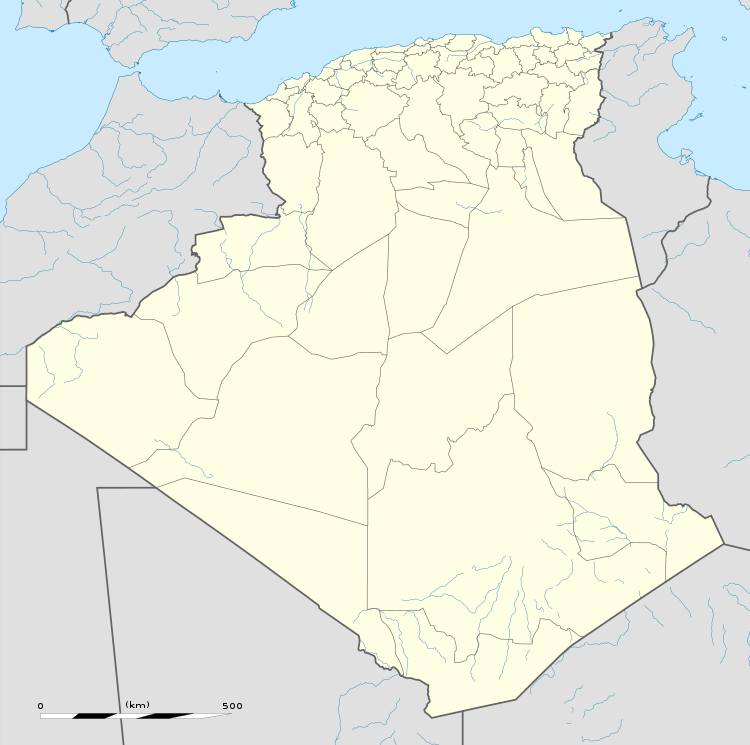Quiza Xenitana
Quiza, which Pliny the Elder called Quiza Xenitana,[1] was a Roman–Berber colonia, located in the former province of Mauretania Caesariensis. The town is identified with ruins at Sidi Bellater, Algiers.
Map showing "Quiza", just west of Cartennas, on the coast of Mauretania Caesariensis | |
 Shown within Algeria | |
| Alternative name | Quiza Cenitana |
|---|---|
| Location | Algeria |
| Region | Mostaganem Province |
| Coordinates | 36.025896°N 0.26658°E |
History
Quiza Cenitana was a place located on the coast of Mauretania Caesariensis. Various ancient authors refer to it by different terms – colonia (Ptolemy), municipium (Antonine Itinerary), and oppidum (Pliny the Elder). Pleiades
Quiza was originally a small Berber village, with Phoenician roots. It grew under the Roman empire. Around 120 AD, the emperor Hadrian erected an arch in the city.
William Smith identified Quiza with Giza near Oran, Algeria.[2] More recent investigations have identified it with present-day El-Benian on the coast road between Mostaga and Dara.[3][4][5]
In his Natural History, 4.2.3., Pliny the Elder: writes: "Next to this is Quiza Xenitana, a town founded by strangers"; a remark explained because the word Xenitana is derived from Greek ξένος, "a stranger",[6] as explained also by Victor Vitensis.[7] The town is mentioned also by Pliny elsewhere (5.2), by Ptolemy, and by Pomponius Mela.[2]
Bishopric
Quiza is also a titular see of Christianity. Quaestoriana was in the ecclesiastical provence of Byzacena.[8]
At the Council of Carthage (411), which brought together Catholic and Donatist bishops, Quiza was represented by the Catholic Priscus, who had no Donatist counterpart. He is mentioned also in a letter of Saint Augustine to Pope Celestine I.[9] Tiberianus of Quiza was one of the Catholic bishops whom the Arian Vandal king Huneric summoned to Carthage in 484 and then exiled. In addition, the name of a Bishop Vitalianus appears in the mosaic pavement of the excavated basilica of Quiza.[10][11][12]
Bishops
No longer a residential bishopric, Quiza is today listed by the Catholic Church as a titular see.[13]

- Priscus fl 411.
- Tiberianus of Quiza fl 484
- Vitalianus
- Adrien André Maria Cimichella, O.S.M. † (5 Jun 1964 Appointed – 21 Jul 2004 Died)
- José Guadalupe Torres Campos (10 Dec 2005 Appointed – 25 Nov 2008 Appointed, Bishop of Gómez Palacio, Durango)
- Cirilo B. Flores † (5 Jan 2009 Appointed – 4 Jan 2012 Appointed, Coadjutor Bishop of San Diego, California)
- Linas (Genadijus) Vodopjanovas, O.F.M. (11 Feb 2012 Appointed – 20 May 2016 Appointed, Bishop of Panevėžys)
- Anthony Randazzo (24 Jun 2016 Appointed - 7 Oct 2019 Appointed, Bishop of Broken Bay)[14]
- Ján Kuboš (25 Mar 2020 Appointed)[15]
See also
References
- This is sometimes mistakenly written Quiza Cenitana
- Smith's Dictionary of Greek and Roman Geography (1854)
- Marietta Horster, Bauinschriften römischer Kaiser (Franz Steiner Verlag 2001 ISBN 978-3-51507951-8), p. 434
- Wolfram Letzner, Lucius Cornelius Sulla (LIT Verlag 2000 ISBN 978-3-82585041-8), p. 45
- Herbert Cancick et al. (editors), Brill's New Pauly (Brill 2006 ISBN 978-9-00412272-7), p. cxcv
- Elder.), Pliny (the (1855). The Natural History of Pliny. Henry G. Bohn.
- Ruinart, Thierry (1699). Historia persecutionis Vandalicæ in duas partes distincta. Prior complectitur libros 5 Victoris Vitensis episcopi, & alia antiqua monumenta. Posterior Commentarium historicum de persecutionis Vandalicæ. Opera & studio T. Ruinart.
- Quiziensis Archived April 2, 2015, at the Wayback Machine at catholic-hierarchy.org.
- Hippo.), Saint Augustine (Bishop of; Rotelle, John E. (2004). Letters 156-210: Epistulae II. New City Press. ISBN 9781565482005.
- J. Mesnage, L'Afrique chrétienne, Paris 1912, p. 484
- Stefano Antonio Morcelli, Africa christiana, Volume I, Brescia 1816, p. 260
- Pius Bonifacius Gams, Series episcoporum Ecclesiae Catholicae, Leipzig,] 1931, p. 467
- Annuario Pontificio 2013 (Libreria Editrice Vaticana 2013 ISBN 978-88-209-9070-1), p. 957
- http://www.catholic-hierarchy.org/diocese/d2q03.html}
- https://www.tkkbs.sk/view.php?cisloclanku=20200325015
Bibliography
- Laffi, Umberto. Colonie e municipi nello Stato romano Ed. di Storia e Letteratura. Roma, 2007 ISBN 8884983509
- Mommsen, Theodore. The Provinces of the Roman Empire Section: Roman Africa. (Leipzig 1865; London 1866; London: Macmillan 1909; reprint New York 1996) Barnes & Noble. New York, 1996
%2C_Algeria_04966r.jpg)